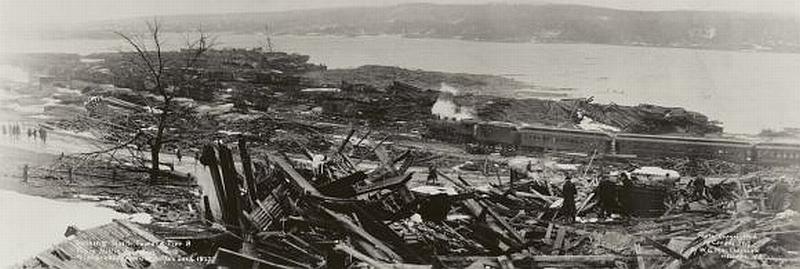 One hundred and seven years ago today, on the morning of December 6, 1917, the French freighter SS Mont-Blanc and the SS Imo, a Norwegian ship chartered to carry relief supplies to Belgium, collided in the Narrows, a strait connecting the upper Halifax Harbour to Bedford Basin. The collision at first seemed minor, the two ships hitting at only about a knot.
One hundred and seven years ago today, on the morning of December 6, 1917, the French freighter SS Mont-Blanc and the SS Imo, a Norwegian ship chartered to carry relief supplies to Belgium, collided in the Narrows, a strait connecting the upper Halifax Harbour to Bedford Basin. The collision at first seemed minor, the two ships hitting at only about a knot.
Nevertheless, a fire broke out aboard the Mont-Blanc, which was loaded with munitions and high explosives. The fire burned out of control and ignited the cargo, causing the largest man-made explosion the world had ever seen before the nuclear age. Roughly 2,000 died and 9,000 were injured. Many thousands more were made homeless. Large sections of Halifax, Nova Scotia were leveled. A tsunami created by the blast wiped out the community of Mi’kmaq First Nations people who had lived in Tuft’s Cove, on the harbor’s eastern shore.
The video below is footage following the 1917 Explosion in Halifax, showing the devastation and the relief effort, beginning with activities the day after the Explosion and following the reconstruction in the north end of Halifax. Check out the 1917 Halifax Explosion in the Nova Scotia Archives to learn more.
Halifax Explosion: The Aftermath and Relief Efforts (1917)
First Responders and the Boston Christmas Tree
Relief efforts began almost immediately from Eastern Canada and the United States but were impeded by a blizzard. Boston authorities heard of the disaster by telegraph and sent a relief train around 10 pm. The blizzard delayed the train, which finally arrived in the early morning of December 8, and immediately began distributing food, water, and medical supplies. The train from Boston carried some of the first responders to the disaster.
In 1918, a year after the explosion, Nova Scotia donated a large Christmas tree to the city of Boston in thanks and remembrance for the help the Boston Red Cross and the Massachusetts Public Safety Committee provided immediately after the explosion. Another tree was donated in 1971 and trees have been donated to Boston every year since. Last night, a tree from Nova Scotia was lit on Boston Commons in remembrance of the Halifax disaster 107 years ago and the support and assistance provided by the people of Boston.

When I visited the Bedford Road cemetry in 1981 after joining the Norwegian sailing ship Sorlandet I saw the graves of Titanic victims and the mass graves for those killed in the Halifax explosion, not knowing then what it was about when hitching a lift back to town I asked and the lift took me to a hill above Halifax where I was shown a large lump of metal anchor surrounded by iron railings, I was told it came from one of the ships and that was where it landed and had to stay. Some years later I met the ex submariner and folk singer Tom Lewis and he told me that when housebuilding was going in the area the lump of anchor some 3/4 mile from the harbour was moved and resited but had to be put back as that was where it landed and where it had to stay.